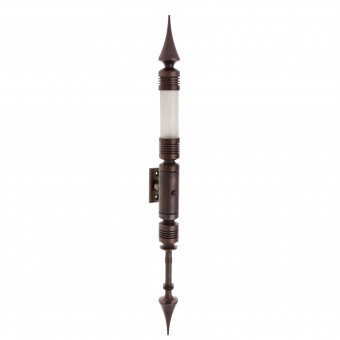Doorbell Residential Doorbell & Light by David Alan Peters |
Home > Winners > #24682 |
 |
|
||||
| DESIGN DETAILS | |||||
| DESIGN NAME: Doorbell PRIMARY FUNCTION: Residential Doorbell & Light INSPIRATION: The inspiration came from a desire I have had for many years, to create a useful product I could manufacture and create a successful business around. This doorbell is actually modeled after a dream I had. UNIQUE PROPERTIES / PROJECT DESCRIPTION: It is a unique design for a doorbell where it does not mount flat on the wall but is cylindrical and supported out 1" from the wall by means of a mounting post and plate. It has a water resistant and removable cylindrical glass shade, illuminated by a replaceable LED that sheds more light than your typical doorbell. Like fine hardware it is precision machined of Aluminum and the Patina simulates oil rubbed bronze. OPERATION / FLOW / INTERACTION: This Doorbell functions like any other however it has an ornamental cylindrical shape and projects out slightly from the wall that together with its illumination encourages curiosity and then the realization “Oh, it’s a doorbell. Cool!” PROJECT DURATION AND LOCATION: This project began in South Carolina USA 9-25-09 I had a dream about what I was working on around the end of October and I altered my design to be more like my dream on 11-1-09 I then made minor alteration on 3-21-10 I moved to South Florida in Feb of 2011 and then made final changes before prototypes on 4-10-11 and have made slight modifications to the final technical aspects of the designs on 8-25-11 FITS BEST INTO CATEGORY: Lighting Products and Fixtures Design |
PRODUCTION / REALIZATION TECHNOLOGY: This product is machined on a precision CNC lathe. It is machined out of 28mm diameter (1 1/8") 6061 T6 Aluminum Rod. It has a 3mm thick Borosilicate cylindrical glass shade that has been sand blasted inside and out to diffuse the light source, illuminated by a replaceable low voltage G4 9-18VAC 1 watt 30lm 2800-3500K LED with built-in driver and an Aluminum housing with a 340Deg. beam angle plastic lens. The G4 socket is ABS. A miniature momentary contact push button RoHS compliant switch rated @ 1A 125VAC. 30K (min) electrical life cycle. All wiring is 22GA with silicone insulation. The Aluminum fixture is dipped in a proprietary water based solution to give it an aged Bronze Patina and then it is sprayed with a two part super hard UV resistant Semi-gloss lacquer. The patina continues to slowly age (for several days) after the lacquer is applied to a richer slightly darker Patina. SPECIFICATIONS / TECHNICAL PROPERTIES: The fixture its self is 28mm in diameter (1 1/8") and 451mm long (17 3/4") it has a short mounting post attached to a mounting plate. The overall projection is 51mm (2") from the wall when mounted. Package dimensions are 12.7cmX12.7cmX55.8cm TAGS: Door bell, Doorbells, LED, Exterior, Accent lighting, cylindrical, Bronze Patina, Unique, Aluminum, Machined RESEARCH ABSTRACT: Since I am a creative visual thinker the dominant type of research in this project consisted of extensive brainstorming and day dreaming, lots of sketches and finally technical drawings. The objective of this project was to design a useful and marketable product for either the furniture or lighting industry. A product I could create a manufacturing business around, be excited about operating and would in turn provide a decent living for my family. I also wanted this product to be respectful to the environment and mindful of the green movement, this is why I chose Aluminum, LED illumination, an RoHS switch and a water based patina. Extensive research was done to decide on the right Aluminum alloy, the right type and size of glass and electrical components. I also did extensive research to find the right suppliers. The internet was my primary tool for gathering information, my secondary source was calling on professionals in the field. Tom Scott, a highly skilled former machine shop owner now retired, was instrumental in creating for me beautiful and precise prototypes resulting in the fruition of these doorbells. It has been very gratifying to have this product come this far, from a visual concept in my mind to reality. I am confident that with the help of colleague's I will be successful creating a business and Guidepost Doorbells will adorn homes and captivate guests before they are even received. CHALLENGE: My early designs were such that it would take a lot of machining on a milling machine. When I took these ideas to machinists to get an Idea of what it would cost the costs I felt were much higher than I wanted them to be for a doorbell. I thought about this for many days and tried coming up with new designs and then that is when I had my dream that changed the design from one that was manufactured by a milling machine to one that could be manufactured on a CNC lathe. The new designs were much more affordable to produce. Due to the small scale of the fixtures body it was difficult to find just the right switch for it. I started out with a tiny 1/4" diameter x1/4" long screw in micro momentary contact switch but I later decided after my prototypes had been made that the pressure needed to push the switch was too light. It was a tactile issue, I later went to a slightly larger miniature switch that needed a little more force to make the contact. This move to a larger switch worked out great also because I later decided that these fixtures could also be Lights and not just a doorbell, with the new larger switch I could have either a momentary switch or an on/off type switch and they were both the same size so they are interchangeable, a big plus for saving on production. I also had to create a custom tool to install the pre-wired switch due to the small size of the doorbell fixture and the depth into the fixture that the switch is mounted at. It also took some time to source out the proper LED for the fixture. It had to be replaceable so I decided on using a G4 socket for the LED. At first I designed one on my own but felt it would not be reliable enough and would be time consuming to assemble hence costing too much. After allot more research on the internet I finally found a G4 LED the right size with the right electrical requirements, lumens and color temperature. I also redesigned the mounting post and plate several times before I felt it was just right. You need to have the fixture sideways to screw the mounting plate to the wall and then up right it and keep it vertical so I have a, what I call a lock tight nut on the mounting post that bears against the mounting plate when you tighten it and it firmly holds the fixture vertical. ADDED DATE: 2012-01-18 12:44:09 TEAM MEMBERS (1) : David Peters, Tom Scott - Prototype Machinist IMAGE CREDITS: David Alan Peters, 2011. |
||||
| Visit the following page to learn more: http://davidalanstudios.com/doorbells-im |
|||||
| AWARD DETAILS | |
 |
Doorbell Residential Doorbell & Light by David Alan Peters is Winner in Lighting Products and Fixtures Design Category, 2011 - 2012.· Read the interview with designer David Alan Peters for design Doorbell here.· Press Members: Login or Register to request an exclusive interview with David Alan Peters. · Click here to register inorder to view the profile and other works by David Alan Peters. |
| SOCIAL |
| + Add to Likes / Favorites | Send to My Email | Comment | Testimonials | View Press-Release | Press Kit |
Did you like David Alan Peters' Lighting Design?
You will most likely enjoy other award winning lighting design as well.
Click here to view more Award Winning Lighting Design.





